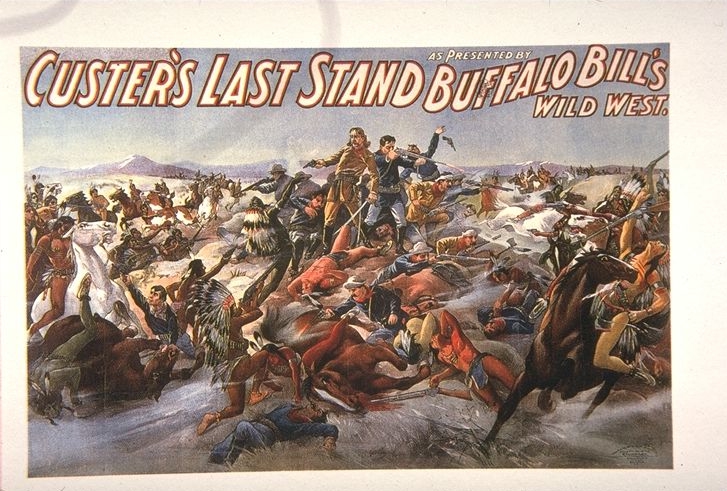
Broadside for Buffalo Bill's Wild West
In 1883, with Doc Carver and Capt. A. H. Bogardus, Cody organized his touring Wild West show. As observed on the preceeding page, one of the
center pieces of the show was the Duel. Additionally, Custer's Last Stand, as illustrated in the
broadside reproduced above, was a featured presentation. The Last Stand starred six foot four inch tall William Levi "Buck" Taylor (1857-1924) as Custer.
In an age when the average cowboy was five foot eight inches tall, Buck Taylor made an impressive Custer.
In the production, the circle of soldiers under attack by the Indians gradually became smaller and
smaller. At the end when all had been killed, Cody would dramatically appear, while a
sign would be projected on a backdrop, "Too Late!"
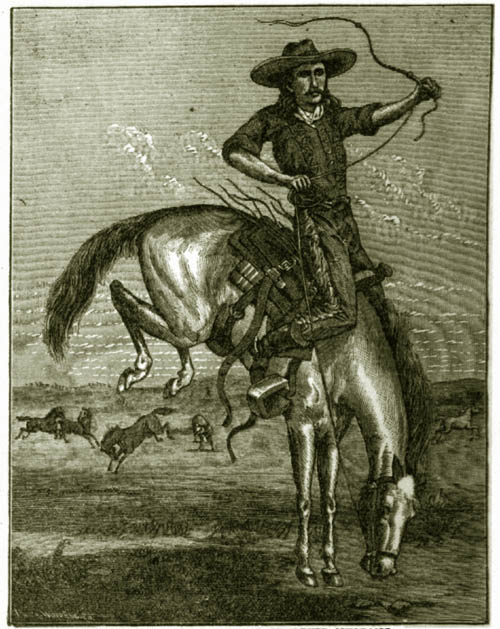
Buck Taylor, Riding a Wild Mustang."
The Taylor was a "real" cowboy. On behalf of Cody's partners, Luther and Frank North, Buck and his brother
James Baxter "Bax" Taylor" had trailed cattle from Texas to the Cody & North ranch on the Dismal River near
North Platte, Nebraska. The Taylor children were orphaned when their father was killed in the Civil War and their
mother died shortly thereafter. Buck Taylor later told a reporter that his grandfather and uncle had died at
the Alamo. After taking Luther North's trail herd to Nebraska, both The Taylor brothers were employed on the ranch. Bax was regarded by Luther North as the best broncho buster
he had ever seen. Buck in one roundup acted as a "rep" for Cody & North. On round-up he was noted
for his love of biscuits. He ate 24 in one sitting. When kidded by his mess mates, he threatened to eat 24 more. Later,
when in the Wild West show he loved pie, pie for breakfast, lunch, dinner, midnight snack, and when in
in England, for afternoon tea. In Texas, their older sister Mary, also had a reputation as a
good horsewoman. The San Saba News, July 05, 1889, described her as able to "ride the worst broncho, or rope the most refracting old cow in the county."
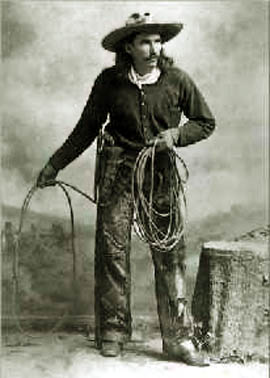 .. ..
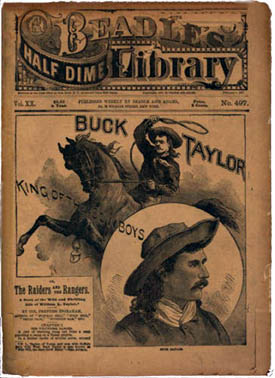
Left, Buck Taylor, Prince of the Lasso, 1890.
Right, Cover, Beadle's Half-Dime,
Buck Taylor, King of the Cowboys, in Raiders and Rangers.
With the organization of Cody's Wild West show, Buck, with his red shirt and emroidered sombrero, became the
star. At the time cowboys were generally held in low repute, but as a result of the show, Buck came to the
attention of Prentiss Ingraham's, the author of Cody's dime novels. A series of novels in which
Buck was the central hero were written by Ingraham: The Prince of the Lasso; Buck Taylor, the Saddle King; The Cowboy Clan or, The Tigress of Texas, A Romance of Buck Taylor
and his Boys in Buckskin; Buck Taylor, King of the Cowboys; Buck Taylor, The Commanche's Captive; Buck Taylor's Boys or, The Red Riders of the
Rio Grande; and Raiders and Rangers. In the latter novel, Buck rescued the Texas Rangers Captain "McNally," daughter. Captain "McNally was
apparently based on real-life Leander Harvey NcNelly, a captain in the Rangers. Taylor was portrayed as a hero rescuing damsels in distress.
It has been contended that Taylor became the prototype for subsequent movie cowboys.
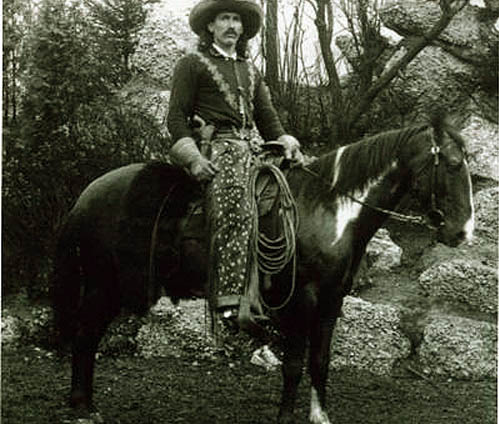
Buck Taylor, approx. 1890.
Buck remained with Col. Cody until about 1890 and appeared in Cody's first European tour before the Queen in 1887. In one show
as he was participating in a quadrille on horse back, the horse on his right collided
with with Buck's right leg, fracturing his thigh bone.
Buck's popularity was such that London newspapers published daily bulletins as to his condition and the American
Minister to the Court of St. James paid a visit to the hospital.
About 1890, Bax Taylor had moved to Wyoming and worked for
a period of time on the 71 Quarter Circle managed by John Clay. The two brothers organized their own ranch on Long Creek near Rongis in Fremont County.
In March, 1892, Newspaper readers across the nation were shocked to learn
that Buck had been killed. The March 23, 1892, Ft. Worth Gazette reported that Buck had been mortally wounded in a shooting fracas at
Rongis, Wyoming. The New York Times, March 16, 1892 reported that the fight had occurred on Monday, March 14 in Rongis. Allegedly also injured with knives were
Pat Horrigan and Al Dougherty. Fortunately, the reports were premature and in error. In 1892, Buck was appearing in other shows. By 1894, Buck had established his own
show appearing in California. Buck's show was similar to Col. Cody's Wild West featuring both Ogallalla and Brule Sioux, an Indian attack on a settler's cabin, the attack on the
stage coach and wagon train and a buffalo chase. His opening show, in San Francisco had one disturbing note, the local Humane Society attempted to stop lassoing and riding of steers.
At the insistence of the Humane Society, Buck was arrested for cruelty to animals. The Jury found him not guilty.
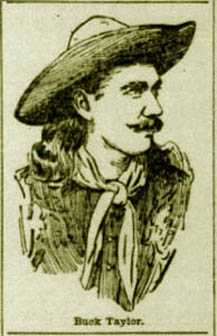 .. ..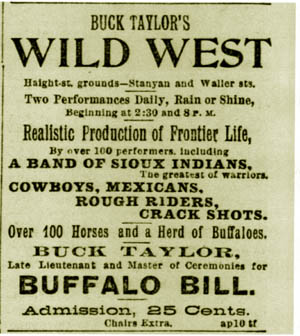
Left, Buck Taylor, 1894; Right, Advertisment for San Francisco showing of Buck Taylor's Wild West.
The following year, Buck was appearing in a show along the East Coast known as the Wyoming Wild West. The Wyoming Wild West had a bad reputation for permitting
hangers-on to operate shell games. In New Jersey the show was broken up by irate Rutgers and Princeton students who had been taken in the shell
games. Fire crackers and other fire works were thrown under the orator's stand just as Buck was to make his appearance. The buffalo was set loose, steers were freed. Spectators fled the tent.
One of the students attempted to "arrest" one of the cowboys. In Maine, things were hardly better with
complaints relating to illegal shell games. In Quebec City, the show went belly-up, stranding the Indians.
Quebec City municipal authorities put the Indians on a boat for Montreal where they were again stranded penniless. A kindly Canadian
was enduced by American authories to put up $150.00 to get the Indians back to the
United States. The government promised that the benefactor would be reimbursed. There is an old cowboy saying,
"You can always trust the government, ask any Indian." At first, the United States government at first refused to pay the reimbusement. Ultimately after
a long delay, the money was repaid by taking it
out of the Indians' annual annuities. By 1897, Buck was back in California. From there, he moved to Pennsylvania to become
the superintendent of a the Betzwood Stock Farm at Valley Forge.
Baxter Taylor was killed in 1897 when thrown from his wagon near Rongis. In 1900, once again newspapers reported the
death of Buck Taylor. Again, the reports of Buck's death were premature. Buck was the victim of an early form of "identiy theft."
The decedent was a former actor and Gilbert and Sullivan opertta singer, Berry F. Tatum. Tatum at one time played Ralph Rackstraw in
Gilbert & Sullivan's H.M.S. Pinafore; or the Lass that Loved a Sailor.
Perhaps, Tatum claims to be Buck Taylor were inspired by the
plot the Pinafore. In a typical Sir William Gilbert plot, Rackstraw and the
Captain were really each other. Tatum pretending to be Buck Taylor served with Roosevelt in Cuba having enlisted in Trooop E of the
Rough Riders from Las Vegas, New Mexico, under the name "Berry F. Taylor." Later, he even
gave a political speech endorsing Col. Roosevelt. The audience loved the speech. Roosevelt was less than
amused. Tatum told the audience: "My fellow citizens, vote for my Colonel! Vote for my Colonel! and he will lead you, as he led us, like sheep to the slaughter."
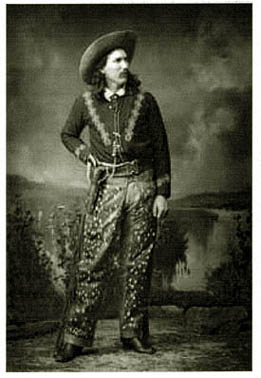 .. ..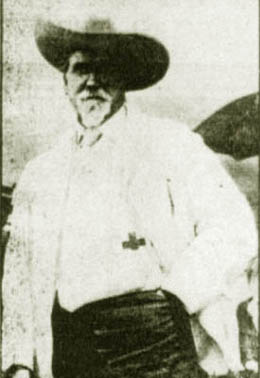
Left, Buck Taylor, approx. 1890; Right, Buck Taylor, 1917.
As Buck Taylor, Tatum picked up money by endorsing a magic elixir, "Peruna." Peruna
advertised that it cured "catarrh, coughs, influenza, la grippe" The advertisements claimed that
"No case of catarrh can enitrely resist the curative virtues of Pe-ru-na, as every case is either cured or permanently
benefited. The endorsements by Tatum were always signed "Buck F. Taylor." It will be recalled that the real
Buck Taylor's name was William Levi Taylor." The endorsements by the fake Taylor were withdrawn by the Peruna
manufactorer upon Tatum's death. He died from consumption. Peruna was a popular remedy until it was revealed that
its ingredients consisted of alcohol, water, flavoring, and burnt sugar for color. Peruna, however,
regained popuarity during the Great Depression. Peruna was about 75 proof. Today, Peruna is remembered only in the
Southern Methodist University mascot, a Shetland pony named "Peruna," and in name of its fight song.
Buck Taylor died in Pennsylvania in 1924. Since then, other cowboy actors have used the term "King of the Cowboys" and the
name "Buck Taylor."
Next page, Jim Willoughby ("Jim Kid"), Bronco, Sharpshooter, Lillian Francis Smith ("Princess Wenona")
|